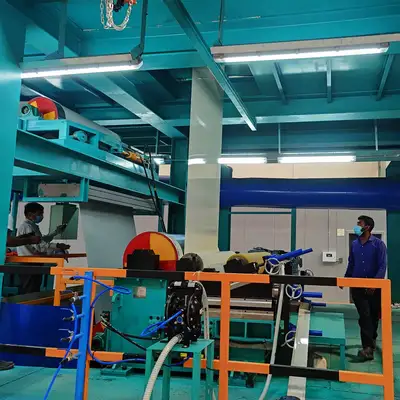In today's manufacturing landscape, environmental responsibility is no longer optional—it's a business imperative. HiTo Engineering has positioned itself at the forefront of sustainable industrial practices by designing aluminum coil coating lines that significantly reduce environmental impact while maintaining exceptional production standards. These systems represent a paradigm shift from traditional finishing methods, offering substantial ecological advantages throughout the coating process. From reduced emissions and energy conservation to waste minimization and compliance with stringent environmental regulations, HiTo's engineering approach demonstrates that manufacturing excellence and environmental stewardship can successfully coexist, creating value for both businesses and the planet.
Dramatic Reduction in Volatile Organic Compound Emissions
One of the most significant environmental benefits of HiTo's coil coating technology is the substantial reduction in volatile organic compound (VOC) emissions compared to traditional spray painting operations. Their enclosed coating application systems capture approximately 95% of VOCs, which are then efficiently destroyed through integrated thermal oxidizers. These systems convert harmful pollutants into carbon dioxide and water vapor through high-temperature combustion, achieving destruction efficiencies exceeding 99%. This closed-loop approach stands in stark contrast to conventional open spraying, where a significant portion of VOCs escape into the atmosphere, contributing to air quality issues and potential health concerns for workers and surrounding communities.

Superior Energy Efficiency Through Heat Recovery Technology
HiTo Engineering's coating lines incorporate sophisticated energy recovery systems that dramatically reduce overall energy consumption. The thermal oxidizers used for VOC destruction capture heat generated during the combustion process and redirect it to preheat incoming oven air, significantly reducing the energy required to maintain curing temperatures. Additionally, many HiTo systems feature heat recovery ventilators that transfer thermal energy from oven exhaust streams to incoming fresh air. These integrated energy recovery approaches typically reduce fuel consumption by 20-40% compared to conventional systems, lowering both operating costs and the carbon footprint associated with the coating process.
Minimal Waste Generation Through Precision Application
Traditional liquid painting methods typically achieve only 30-40% transfer efficiency, with the majority of paint becoming waste through overspray. HiTo's precision roll coating technology achieves near 100% transfer efficiency, applying exactly the required amount of coating to the substrate without overspray. This precise application method eliminates the need for solvent washing of spray booths and significantly reduces hazardous waste generation. The closed-system design also allows for collection and reuse of excess coating material, further minimizing waste. This approach not only reduces environmental impact but also translates into substantial cost savings on raw materials and waste disposal.
Water Conservation and Chemical Management Advantages
HiTo's pretreatment systems are designed for water efficiency and chemical conservation. Many systems incorporate counter-flow rinsing techniques where cleaner water from later rinse stages is reused in earlier stages, significantly reducing overall water consumption. Advanced filtration and monitoring systems maintain chemical bath effectiveness longer, reducing the frequency of dump-and-replace cycles that generate hazardous wastewater. Some systems even feature evaporation technology that concentrates waste streams, minimizing the volume of material requiring disposal. These water management approaches demonstrate HiTo's commitment to conserving resources throughout the coating process.
Compliance with Stringent Environmental Regulations
HiTo Engineering designs its systems to not only meet current environmental regulations but to anticipate future requirements as well. Their integrated emission control systems typically exceed regulatory compliance standards, providing manufacturers with a comfortable margin of safety as regulations become increasingly stringent. This forward-thinking approach protects businesses from costly retrofits and compliance issues down the road. The comprehensive environmental performance data generated by HiTo's monitoring systems also simplifies regulatory reporting and demonstrates due diligence to environmental agencies and stakeholders.

Support for Sustainable Product Lifecycles
The environmental benefits of HiTo's technology extend beyond the manufacturing process to the complete lifecycle of coated aluminum products. The exceptional durability of coil-coated finishes extends product lifespans, reducing the frequency of replacement and associated resource consumption. The superior corrosion resistance of properly coated aluminum ensures that products maintain their integrity and appearance for decades, minimizing maintenance requirements and the associated environmental impacts of repainting or refurbishment. At end of life, the aluminum substrate remains highly recyclable, maintaining its value in the circular economy while the minimal coating thickness doesn't significantly impact recycling processes.
Enhanced Workplace Environmental Conditions
HiTo's enclosed systems significantly improve indoor environmental quality for manufacturing personnel. By containing coating operations and effectively capturing emissions, these systems dramatically reduce worker exposure to VOCs and other potentially harmful substances. The improved air quality creates a healthier work environment while simultaneously reducing the need for extensive personal protective equipment and ventilation systems that consume additional energy. This human-centered environmental benefit demonstrates HiTo's comprehensive approach to sustainability, recognizing that protecting both planetary and human health are essential components of responsible manufacturing.




Comments